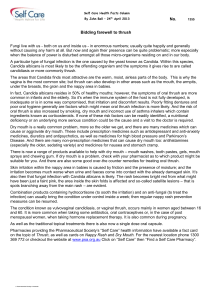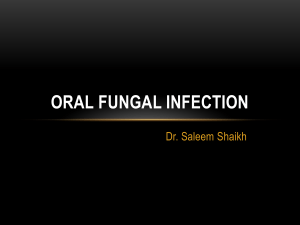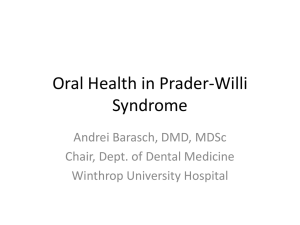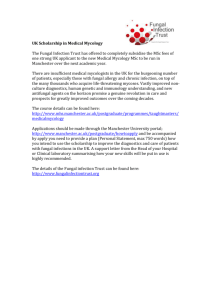Clinical Case #21
advertisement
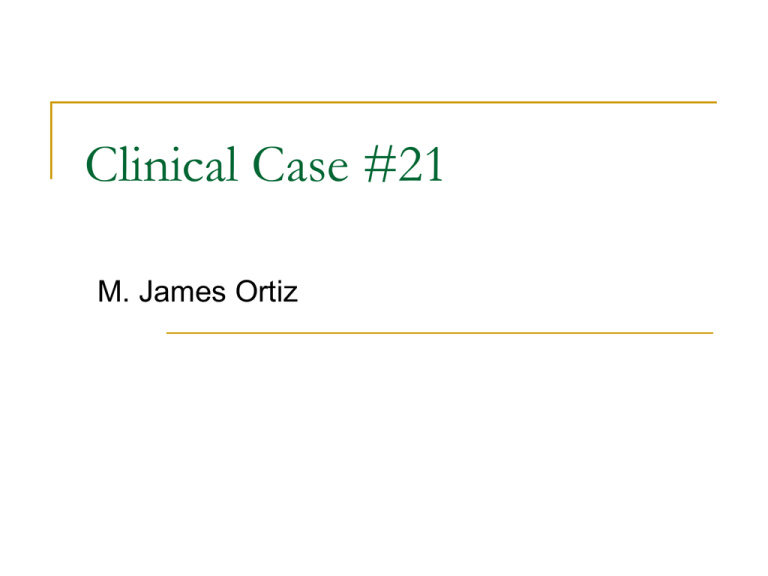
Clinical Case #21 M. James Ortiz Case #21 Baby girl Ciara, 3 months of age, born at the Rural Health Center, was seen at Fatima because of white spot in the tongue and buccal mucosa described by her mother as remaining milk curds. Working Diagnosis: Oral Candidiasis Questions: What are the drugs you would prescribe? Mechanism of action of your drug regimen. How would you give the medication? What other advice would you give to the parents/guardian of your patient? What is Oral Candidiasis? Oral Candidiasis (oral thrush) is a superficial fungal infection, which is very common in infants and young children caused by the yeast-like fungus Candida albicans. C. Albicans is a commensal of the oral cavity, gastrointestinal tract and vagina. MOST COMMON CAUSE OF FUNGAL INFECTION Potential Site for infection in disseminated systemic candidiasis : GIT, Trachea, Lungs, Liver, Kidneys and CNS may result in septicemia, meningitis, hepatospleenic disease, and endocarditis Diagnostic Test The diagnosis of oral candidiasis is most frequently made on the basis of clinical appearance along with exfoliative cytology examination. This involves the Histological Examination of intraoral scrapings which have been smeared microscope glass slides. A 10% - 20% Potassium Hydroxide Preparation ("KOH prep") can be used for immediate microscopic identification of yeast cell forms. Gram staining reveals Large gram-positive yeast Oral Candidiasis Clinical Signs & Symptoms Pseudomembrane that is a white nonadherent plaques on the buccal mucosa and the palate over a erythematous base. This membrane consists of desquamated epithelial cells, fibrin, leukocytes, and fungal mycelium that attaches it to the inflamed epithelium. Difficulty feeding with infants Antifungal Agents: Treatment of Oral Thrush Polyene Macrolide Antibiotics Nystatin* Amphotericin B Azoles Imidazoles Ketoconazole Miconazole Clotrimazole Triazoles Fluconazole How would you give the Medication? Keep in consideration the age and type of infection. For infants antifungal agents administered Topical antifungals are usually the drug of choice for uncomplicated, localized candidiasis in patients with normal immune function. Oral Suspension Topical gel/cream Systemic antifungals are usually indicated in cases of disseminated disease and/or in immunocompromised patients. Duration of therapy: Medication should be continued for at least 48 hours after the disappearance of clinical signs of candidiasis along with complete healing and the absence of mucosal erythema. Mechanism of Action of Antifungal Agents Cell Wall & Membranous Components Fungal cell wall consists largely of Chitin, a polymer of N-acetylglucosamine, rather than peptidoglycan. Thus uneffected by antibiotics such as penicillin, oxacillin, ampicillin, etc… The fungal membrane consists of ergosterol rather than cholesterol found in mammilian membranes Fungal Cell Wall Polyene Macrolides Azole Antifungals Antifungal Agents NYSTATIN(Mycostatin, Nilstat, Nystex) Pharmacokinetics Absorption insignificant in skin, GIT, or vagina Administered topically or orally MOA Binds to ergosterol in cell membrane forming cytotoxic pores Spectrum of activity C. albucans Indications Mucocutaneous candidal infection. DOC for oral thrush Contraindication Documented hypersensitivity Dosage Adults: 400,000 – 600,000 U PO: swish and swallow 4-5 times/d Dissolve 1-2 (200,000-400,000 U) troches in mouth 4-5 times/d Pediatric: Infants- Apply 100,000 – 200,000 U oral suspension 3-5 times/d Older children- administer as in adults Precautions: No serious adverse effects; bitter taste, nausea, abdominal pain, diarrhea, uticaria AMPHOTERICIN B (Fungizone Oral Suspension) Pharmacokinetics Absorption insignificant in GIT Administered topically or orally MOA Binds to ergosterol in cell membrane forming cytotoxic pores Spectrum of activity C. albucans Indications Mucocutaneous candidal infection Contraindications Documented Hypersensitivity Dosage Adult: 100-200 mg PO; swish and swallow qid Pediatric: Apply 100 mg oral suspension to affected areas of the mouth Interactions unlikely with oral administration due to poor absorption; may increase nephrotoxicity when used with aminoglycosides and possibly with cephalosporins; may increase methotrexate toxicity Precautions Minimal Adverse effects expected with PO administration CLOTRIMAZOLE (Mycelex Troches) NOTE: Not enough studies have been done for children under 3 years of age, thus NOT RECOMMENDED FOR USE IN THESE PATIENTS!!! Pharmacokinetics Topical or Oral Administration MOA Inhibits Ergosterol Synthesis Spectrum of activity Numerous candidal species& Dermatophytes Indications Oral Thrush, Vulvovaginal candidiasis, and Deratophytic Infections Prophylaxis for immunosuppressed individuals: radioactive therapy, renal transplant, etc… Contraindication Documented hypersensitivity Dosage Adult: 10 mg troche dissolved PO 5 times/d Pediatric: Not Establish Interactions: None Reported Precautions Decreased Liver Function MICONAZOLE (Daktar Oral gel) Pharmacokinetics Administered Topically, IV, or Oral Hepatic Metabolism MOA Inhibits Ergosterol Synthesis Spectrum of activity Numerous candidal species & Dermatophytes Indications Mucocutaneous candidal infection& Seborrheic Dermatitis Contraindication Those who are my develop hypersensitivity reaction to active ingredient Sodium Sulfite Anhydrous Pregnant patient Dosage Apply 25 mg to affected areas of mouth qid; Exact topical dose not yet estabilshed Interactions None Reported Precautions Chemical irritation IV or Oral Administration: Blood dyscrasias, Hyponatremia, Anaphylactic reaction, Dysrhythmias, and/or fever FLUCONAZOLE (Diflucan) Pharmacokinetics IV or Oral Administration Crosses the BBB * MOA Inhibits Ergosterol Synthesis Spectrum of activity Numerous candidal species C. neopformans Indications Oral Thrush, Cyprococcal meningitis, Vaginal candidiasis, Prophylaxis for immunosuppressed individuals: Bone marrow transplant and HIV Patients Contraindications Documented Hypersensitivity Dosage Adult: 200 mg PO qd on day 1; followed by 100 mg/d PO for 3-4 d; total 5 d should be adequate Pediatric: 6 mg/kg/d PO qd Interactions Serum levels may increase with hydrocholothiazide Levels may decrease with chronic coadministration of rifampin Codministration may decrease phenytoin clearance Effects of anticoagulants may increase with coadministration Cyclosporine concentrations increases may occur when administered concurrently Precautions Rash, Cholestasis, Hepatitis, and Hepatic Failure and Death with underlying conditions (eg. AIDS, malignancy) and taking multiple concomitant medications KETOCONAZOLE Pharmacokinetics • Administered Topically or taken orally • Hepatic Metabolism MOA • Inhibits Ergosterol Synthesis Spectrum of activity • Broad spectrum: Numerous candidal specie, Endemic mycoses (Blastomyces, Coccidiodes, and Histoplasma), and Dermatophytes Indications • Mucocutaneous candidal infection • Seborrheic Dermatitis • Infections by thoses species listed above Adverse Effects • Very minimal side effects, local topical irritation • Hypersensitivity Reaction • Nausea and vomiting with oral administration • Adrenal and Gonadal steroid synthesis inhibition • Teratogenic (only with extreme orally administered doses) Dosage for pediatric pt. • Apply 2% Ketoconazole cream between meals for 14 days Contraindication • Those who are my develop hypersensitivity reaction to active ingredient Sodium Sulfite Anhydrous Advice to the parents/guardians Candida albicans yeast is EVERYWHERE!!! Clean and sterilize pacifiers, bottles, toys, etc., your baby will likely still be exposed to this yeast. clean any objects that go into your child's mouth. If your baby gets thrush over and over. It may be the bottle or pacifiers. Breastfeeding mothers beware if their baby has thrush may get a yeast infection on their breasts and nipples, causing pain while breastfeeding In older children, especially if they haven't recently been on antibiotics or steroids, thrush can be a sign of uncontrolled diabetes mellitus or any immune system disorder. Infants with thrush that doesn't go away or keeps coming back can also be associated with immune system problems, especially if your infant isn't gaining weight well or has other infections and medical problems. THANK YOU For Your Attention!!!!



